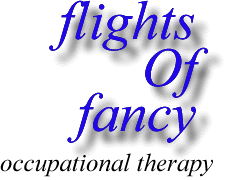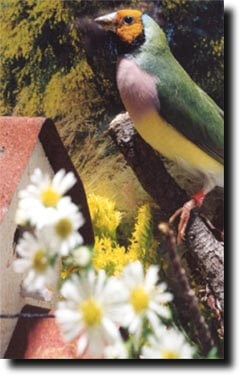
 lady gouldian finch - OH PB Green back hen lady gouldian finch - OH PB Green back hen
Aviary Plants
Articles and Information - Lady Gouldian Finch
Almost every bird enjoys chewing on the bark of a fresh tree branch. Avian vets often recommend such chewing activity as important occupational therapy. Like most breeders dream, my first aviary was decorated from wall to wall with very exotic and very expensive live plants. I tried to replicate indoors what my sister, living in Southern California designed in her backyard aviaries. On my first visit to California, I couldn't wait for sunrise each morning to pour my cup of coffee, wrap a blanket around my legs and rush outside to sit and watch her birds dive and soar in the sunlight and dart from shrub to shrub in excited exploration! It was truly the most soul soothing experience I have ever had.
| |
When I returned home, my dream was to combine both my hobby of raising birds and my love for gardening in my bird room just like my sister. Within the first three weeks I realized my dream had become my nightmare. My finches chewed up and pooped and pooped and pooped on every plant I had in the flight! It was a complete mess! I tried everything to keep the beautifully planted flight clean but in the end I pulled all the plants out. The one thing I didn't take into consideration was that my sister could use her hose. Every couple of days, like magic, she just sprayed all the poops away with her lawn hose! If you decide you want a beautiful planted flight in your home where you can sit and enjoy your birds, make sure you pour a cement floor with a drain first!
Live plants in the bird flight
Although bird owners worry about plant toxicity, veterinarians rarely diagnose plant toxicity in pet birds. I have included a list of safe and possibly harmful plant species, thanks to the efforts of Myra, my webmaster, who spent hours of research to come up with this great list of safe and dangerous plants.


An aviary decorated with live, exotic plants is always the dream when one starts planning for a large-scale aviary. Naturally however the dream can become longer than our homes budgets allow. The complete garden paradise for your birds may have to remain a dream, but that doesn't mean you can't add a little nature to your aviary. Even small, single pair flight cages can be accentuated with a little greenery either beside the cage or draped on top.
Plants do more than just add a little color to your finch set-up. They also provide the finches with a feeling of extra security, especially if they can hide behind or inside the plant. When live plants are used, the plants often become another food source and/or natural nesting material. They also give the finches something on which to perch other than their wooden perches.
Because your finches will chew up, poop, and destroy any plant you provide, always choose a plant that is safe for them (non-toxic). In return it's best to buy a plant which can also survive the finch attacks. For more delicate species, it is best to allow the plant leaves to hang into the aviary or cage while keeping the majority of the plant outside the finch's reach.
Potting soil can be just as dangerous for finches as some plants can be. Most plants sold in stores come with nutrient enriched dirt that is also treated to prevent weed growth. Many of the fertilizers and chemicals used are quite toxic if ingested. Finches are known for trying to eat everything in sight.
If a live plant proves too much of a risk for you, maybe a fake plant would work better. There are two basic types of fake plants: Plastic and Silk. Plastic plants are a bit hardier and handle the chewing quite well. Plus they clean very easily and are fairly inexpensive. Silk plants can literally be unwoven by some of the more determined finches and end up as nesting material. They are a little more expensive than plastic but also cleans up just as well.
If you do chdose a flake plant you must note that many potted fake plants use a painted foam base to simulate dirt. This foam is dangerous for finches and shouldn't be put within beak range. Personally I've always preferred the vine type plastic plants. They don't have a pot and therefore no foam. They are simply a long string of vine, leaves and colorful flowers.
Below is a large list of safe and dangerous plants. Always use your best judgement when selecting any addition to your aviary.
Safe Plants
| Acacia
African Violets
Aloe
Areca / Butterfly Cane
Asparagus Fern
Australian Umbrella Tree
Baby's Tears
Bamboo
Bird Nest Fern
Begonia
Bottle Palm
Boston Fern
Bougainvillea
Bromeliads
Chickweed
Christmas Cactus
Cissus / Kangaroo Vines
Coffee Tree
Coleus
Corn Plant
Crabapple
Creeping Charlie
Dandelion
Dogwood
Donkey Tail / Burro's Tail
Dracaena Varieties
Dragon Tree
Easter Cactus
Gold Dust Dracaena
Elephant Foot Tree
Ferns:
Asparagus (Not A True Fern)
Bird Nest Fern
Boston Fern
Brake
Ribbon
Dish
Button
Motherfern
Maidenhair
Sword
Squirrel's Foot
Deer's Foot
Fiji
Polypody
Ball
Staghorn
Elk's Horn
Gardenia
Gold Dust
Grape Ivy
Hen and Chickens
Hibiscus
Honeysuckle
Impatiens
Jade Plant
Kalanchoe | Magnolia
Mango (fruit)
Marigold
Monkey Plant
Mother-In-Laws Tongue
Nasturtium
Natal Plum
Nerve Plant
Norfolk Island Pine
Orchids
Palms:
Areca Bamboo
Bottle
Fern Date
European Fan
Fan
Fishtail
Howea
Kentia
Lady
Parlour
Phoenix / Date Palm
PonyTail Palm (Not A True Palm)
Pygmy Date
Rhapis
Roebelin
Sentry Palm
Pansies (Purple, white & yellow bi-color blooms are safe)
Passion Flower Vine
Peperomia
Petunia
Pittosporum
PonyTail Palm (Not A Palm)
Prayer Plant
Purple Passion / Purple Nettle
Pyracantha (Ripe Berries Only)
Red-Margined Dracaena
Rose
Rubber Plant
Schefflera (Umbrella)
Sensitive Plant
Snake Plant
Spider Plant / Airplane Plant
Swedish Ivy
Thanksgiving Cactus
Thistle
Toyon Tree / California
Wandering Jew
Wax Plant
White Clover
Velvet Plant / Purple Passion
Yucca
Zebra Plant
Zinnia | Safe Woods
| Apple
Ash
Beech
Citrus (any)
Dogwood
Elm
Eucalyptus
Guava
Kiln dried Pine
Madrona
Magnolia
Manzanita
Maple
Nut (except chestnut & oak) | Oak (clean and disinfect thoroughly)
Papaya
Pear
Pine
Poplar
Prune
Ribbonwood
Sassafras
Thurlow
Vine Maple
Willows:
Goat
Pussy
Weeping | Dangerous Plants / Poison
| Alacia
Amaryllis
American Yew
Apricot
Aralia
Arrowhead Vine
Arum Lily
Autumn Crocus / Meadow Saffron
Australian Flametree
Avocado
Azalea
Balsam Pear
Baneberry
Beans:
Castor
Horse
Fava
Broad
Glory
Scarlet Runner
Mescal
Navy
Purgatory
Birch
Bird of Paradise
Bishop's Weed
Bittersweet Nightshade
Black Laurel
Black Locust
Bleeding Heart / Dutchman's Breeches
Bloodroot
Bluebonnet
Blue Green Algae
Boxwood
Bracken Fern
Broom Corn Grass
Buckthorn
Bulb Flowers:
Amaryllis Daffodil
Narcissus
Hyacinth
Iris
Burdock
Buttercup
Cacao
Camel Bush
Castor Bean
Caladium
Calla Lily
Cana Lily
Candelabra Tree
Cardinal Flower
Chalice Vine / Trumpet Vine
Cherry Tree
ChinaBerry Tree
Christmas Candle
Clematis / Virginia Bower
Clivia
Cocklebur
Coffee (Senna)
Coffee Bean / Rattlebush / Rattlebox & Coffeeweed
Coral Plant
Coriander
Corncockle
Coyotillo
Cowslip / Marsh Marigold
Crape Myrtle
Crown of Thorns
Croton
Cutleaf Philodendron
Daffodil
Daphne
Datura Stramonium / Angel's Trumpet
Deadly Amanita
Death Camus
Delphinium
Devil's Ivy
Dieffenbachia / Dumb Cane
Eggplant (Only friut is safe)
Elderberry
Elephant Ear / Taro
English Ivy
Ergot
Eucalyptus
Euonymus / Spindle Tree
Euphorbia Cactus
False Hellebore
Flame Tree
Felt Plant / Maternity / Air & Panda Plants
Figs: (if much is eaten these plants can make a bird ill)
Creeping
Edible
Fiddleleaf Fig
Laurel Leaf
Rubber Plant
Weeping
Firethorn / Pyracantha
Flamingo Flower
Fly Agaric Mushroom / Deadly Amanita
Four O'Clock
Foxglove
Glory Bean
Glottidium
Golden Chain / Laburnum
Grasses:
Johnson
Sorghum
Sudan
Broom Corn
Ground Cherry
Heaths:
Kalmia
Leucothoe
Pieres
Rhododendron
Mountain Laurel
Black Laurel
Andromeda
Azalea
Heliotrope
Hemlock (Poison in plant & water)
Henbane
Holly
Honey Locust | Horse Chestnut / Buckeye
Horsetail
Hoya
Hyacinth
Hydrangea
Indian Licorice Bean
Indian Turnip
Iris / Blue Flag
Ivy (English & Others)
Jack-in-the-pulpit
Japanese Yew
Jasmine / Jessamine
Java Bean
Jerusalem Cherry
Jimsonweed / Thornapple
Johnson Grass
Juniper
Kentucky Coffee Tree
Lantana / Red Sage
Larkspur
Lily of the Valley (Poison in plant & Water)
Lily, Arum
Lima Bean
Lobelia
Locoweed / Milk Vetch
Locusts: Black & Honey
Lords & ladies / Cuckoopint
Lupine / Bluebonnet
Malanga
Mandrake
Mango Tree
Marijuana / Hemp
Mayapple / Mandrake
Mescal Beans
Mexican Breadfruit
Medican Poppy
Milkweed / Cotton Bush
Mistletoe
Mock Orange
Monkshood / Aconite
Moonseed
Morning Glory
Mountain Laurel
Mushrooms, Amanita
Myrtle
Narcissus
Nectarine
Nettles
Nightshades:
Deadly
Black
Garden
Woody
Bittersweet
Eggplant
Jerusalem Cherry
Nutmeg
Oak
Oleander
Oxalis
Peace Lily
peach
Pencil Tree
Periwinkle
Philodendrons:
Split Leaf
Swiss Cheese
Heart-leaf
Pigweed
Pokeweed
Pine needles & berries
Plum
Poinciana
Poinsettia
Poison Ivy
Poison Hemlock
Poison Oak:
Western
Eastern
Pokeweed / Inkberry
Potato Roots & Eyes
Pothos
Privet
Prune
Pyracantha
Rain Tree
Ranunculus / Buttercup
Rattlebox / Crotalaria
Red Maple
Red Sage / Lantana
Rhubarb (The Leaves)
Rhododendrons
Rosary Pea Seed / Indian Licorice
Sago Palm (Not a True Palm)
Sandbox Tree
Scarlet Runner Beans
Skunk Cabbage
Snowdrop
Snow on the Mountain / Ghostweed
Snowflake
Sorghum Grass
Sorrel
Sudan Grass
Spurges:
Pencil Tree
Snow-on-mountain
Candelabra
Crown of Thorns
Star of Bethlehem
Sweet Pea
Swiss Cheese Plant / Monstera
Tansy Ragwort
Tobacco
Umbrella Plant/Tree
Vetch: Hairy & Common
Virginia Creeper
Water Hemlock
Wattle
Weeping Fig
Western Yew
White Cedar / ChinaBerry
Wisteria
Yam Bean
Yews
Yellow Jasmine |
|
© lady gouldian finch.com 2017